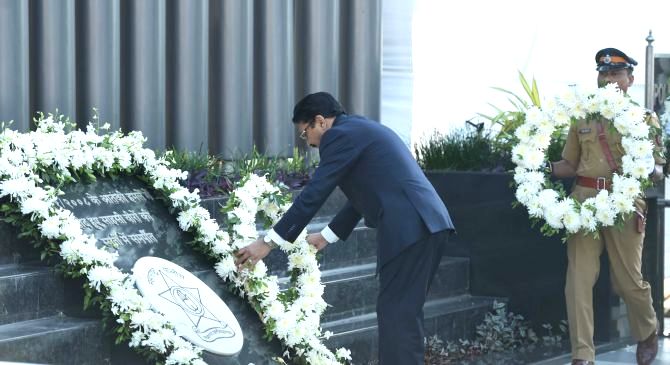Mumbai: Maharashtra Governor C.V. Rao, Chief Minister Devendra Fadnavis, cabinet ministers and top officials paid homage to all those who lost their lives in the 26/11 Mumbai terror carnage here on the occasion of its 10th anniversary Monday.
Rao, Fadnavis and others visited the Martyrs’ Memorial at Chowpatty and offered wreaths and floral tributes to mark the solemn occasion.
Director-General of Police Datta Padsalgikar, Mumbai Police Commissioner Subodh Jaiswal led the police department in the memorial at the venue.
Similar memorials were organised at targeted sites — the Chhatrapati Shivaji Maharaj Terminus, Hotel Taj Mahal Palace, The Oberoi Hotel, Nariman House housing the Jewish community centre, Chabad House in Colaba, the Leopold Cafe and Cama Hospital venues, and other cities in the state.
Marking the occasion, the Nariman House has been rechristened as the ‘Nariman Light House’ from Monday and a permanent memorial to all the victims has been created there.
The ‘Nariman Lighthouse Memorial’ has come up on the rooftop of the building in Colaba and shall be inaugurated later in the day by Education Minister Vinod Tawde and Israeli Ambassador to India, Ron Malka, said the Chabad House Rabbi Israel Kozlovsky.
The first phase of the memorial includes a plaque with the names of all the 166 victims of the 26/11 terror strikes.
A gently flowing fountain in an artificial garden signifying the flow of life, purification and regeneration, and six planks signifying the targeted locations is part of it.
It will be opened for public viewing shortly, the Rabbi added.
It was on a cool night of November 26, 2008, that 10 heavily armed terrorists from Pakistan sneaked into Mumbai through the Arabian Sea route and landed at a fishing jetty in Colaba in a dinghy.
While Abdul Rehman, Abu Ali and Abu Soheb marched to the Leopold Cafe in Colaba and then laid siege at Taj Mahal Palace Hotel, Abdul Rehman Chota and Fahad Ullah headed to the Trident-Oberoi Hotel.
Nasir Abu Umar and Babar Imran alias Abu Aakasha targeted Nariman House housing the Jewish Chabad House; while Isamal Khan, Abu Ismail and Ajmal Amir Kasab unleashed terror at the Chhatrapati Shivaji Maharaj Terminus (CSMT), Cama Hospital and its precincts, before proceeding towards Chowpatty.
For the next 60 hours, they went on a rampage hitting at prominent locations in a small geographical area of barely 4.5 sqkm of south Mumbai and nine were killed during the joint security operations which included the Mumbai Police, army and naval commandos and other paramilitary forces.
In a significant achievement, the Mumbai Police caught Kasab alive near Girgaum Chowpatty. He was tried and finally hanged inside the Yerawada Central Jail, Pune November 21, 2012.
A decade later, learning the grim lessons from the 26/11 experience, the security apparatus was boosted on all fronts, terrestrial, coastal and maritime and the outcome is that though scarred, Mumbai is a much safer metropolis, it is assumed.
Since 26/11, it suffered only one simultaneous triple-terror strike July 13, at Zaveri Bazaar, Dadar and Kalbadevi, during the evening peak hours, leaving 26 dead.
IANS
